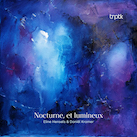

Eline Hensels & Daniël Kramer: Nocturne, et lumineux
TRPTK
There's nothing coy about the title of Dutch cellist Eline Hensels' debut album, as Nocturne, et lumineux clearly captures the tonal essence of the project. While dramatically different in style, all five of the works featured exude a crepuscular tranquility and luminous beauty. The composers are predominantly French, but Czech and Dutch composers—Leoš Janácek and Henriëtte Bosmans, respectively—are also represented. Hensels (b. 1998), who's accompanied on the set by pianist Daniël Kramer, began cello studies at the age of six and is now an award-winning soloist and chamber music performer who's appeared at the Concertgebouw and on Dutch television and radio. Like her, Kramer started on his instrument early and is today an in-demand recital partner and concert soloist. Both musicians are amply equipped to take on the myriad challenges posed by the album material.
Sequenced first is Charles Koechlin (1867-1950), in one sense a quintessential French composer in that he studied at the Paris Conservatoire with Massenet and Fauré; however, his wide range of extra-musical interests, including a passionate interest in astronomy, set him apart. Consistent with that, the staggering volume of music he created bears a distinctive personal signature, with the Cello Sonata, Op. 66 performed here a good illustration. Written in 1917 and premiered seven years later, the work progresses through three descriptively marked movements, “Très modéré, et d'allure bien tranquille” alluringly delicate and poetic, “Andante quasi adagio / Très calme” by turns soothing, mysterious, and rhapsodic, and the passionate “Final. Allegro non troppo” animated, though not so much so it feels disconnected from the other movements.
Of course, Nadia Boulanger's (1887-1979) name is familiar, though more for teaching Piazzolla, Glass, and others than for composing. Her influence as a composition teacher is huge, but the calibre of her own work, even if modest in size, shouldn't be underestimated. That's borne out by Trois pièces, which was written for organ in 1911 and three years later transcribed for cello and piano. The fragile quality of the Koechlin piece carries over into Boulanger's when “Modéré” begins the work with soaring cello supplications buoyed by the piano's delicate lilt. The short “Sans vitesse et à l'aise” movement is as lyrical though comparatively more elegiac and plaintive; diametrically opposed to the other two is the rambunctious “Vite et nerveusement rythmé,” which drives relentlessly forward with rhythmic thrust though it does admittedly catch its breath during a calming middle section.
Also requiring no introduction, Janácek (1854-1928) is represented by Pohádka, a work loosely based on Russian writer Vasily Zhukovsky's The Tale of Tsar Berendyey. While the composer didn't provide clarification as to how exactly the musical material should be interpreted, it's surmised that the piece focuses on the budding romance between Prince Ivan and Princess Maria, with the cello personifying him and the piano her. The enchantment of new love is intimated by the tentative exchanges between the instruments at the start of “Con moto” and in their gradual union; rapture grows in the central movement, after which the closing “Allegro” imparts impressions of triumph and celebration.
The album's sole single-part piece is by Bosmans (1895-1952), whose Nuit calme actually forms the second movement of her 1926 composition Impressions. Structured in ternary form, the piece singlehandedly embodies the tone implied by the Nocturne, et lumineux title when long, sustained cello notes float dreamily over a lulling piano base. Consistent with its ABA design, however, its middle section evidences some degree of agitation before the twilight calm of the intro reinstates itself.
Hensels and Kramer frame the album smartly by capping it with another work by a renowned French composer, this time the Cello Sonata, FP 143 by Francis Poulenc (1899-1963). Initiated in 1940 and completed eight years later (WWII complicating the writing process), the four-movement work is at nearly twenty-three minutes the album's longest. The bright melodic flourishes that jumpstart the graceful opening movement might suggest the work will be radiant throughout, but it's hardly one-dimensional: there are romantic, sombre, and sorrowful moments and even a few humorous ones too. The “Cavatine” movement enters with a dignified chorale-like statement in the piano before taking a brooding turn, the cheery “Ballabile” re-visits the joyous tone of the opening part, and the grand “Finale” asserts itself with authoritative declamations.
The sensitivity Hensels and Kramer demonstrate in these eloquently articulated renditions reflects tremendously on the high level of musicianship they've achieved. The intensity of their outpourings in the second movements of the Janácek and Poulenc works likewise testifies to the deep level of engagement the recital partners bring to all of the material on the release.April 2024